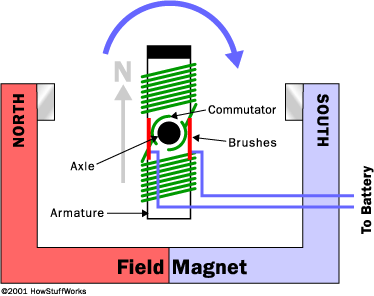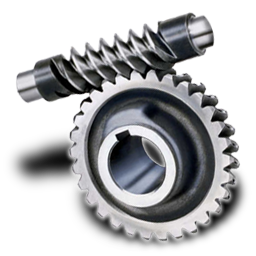Windshield Wipers
Short Description of Topic
Importance
Windshield wipers are now standard in every car made in the world, and they have a crucial function for those of us who need cars to get around during raining weather. Windshield wipers are a common invention in modern times that we take for granted, but the source of their technological advancement stems from the understanding of electrical circuits. Many of the modern electric windshield wipers contain a battery for their power that is a direct current and a field magnet. These components act together to create a rotational motion that you see on the front of your car when you drive in the rain. [1]
Parts

The windshield wiper consists of a few main parts that help turn its electric energy into mechanical energy including: an electric motor and a worm gear inside of the car, and wiper blades.[2]
Motor and Gear
The electric motor and worm gear work together to power the wipers.

Electric Motor
The electric motor is powered by magnets. The alteration of the magnets positions can cause motion of initially resting materials. The attracting and repelling forces present in magnets are used to cause rotational motion. Many motors today and in general use electromagnets, which consist of running a current through a wire around a material via a battery making it a magnet. [3]
Wiper Blades
The wiper blades are effectively squeegees made of rubber that cling to the surface of the windshield and run across the length of the shield scrapping away any water or debris on the surface
Function
As you may have guessed it takes a substantial amount of energy to be able to cycle the windshield wipers back and forth at the varying level of speeds that are provided by the controls inside the car. In order to achieve the motion the worm gear is used as the output of the electric motor. The gear can take the energy provided by the motor, in torques, and multiply it by 50 times the original amount as well as slow the speed at the same magnitude which in turn operates what is called a linkage that moves the wipers back and forth. [4] Inside this assembly is an electronic circuit that can detect when the wipers have reached the down position, this is what then powers the wipers by either allowing the power from the electric motor to reach the wipers, or by cutting the power to the wipers. The linkage mentioned earlier is what acts as the lever arm for the power transfer to the wipers. The wipers then remove the debris from the windhsield. There are multiple configurations of wipers that can be used depending on the manufacturing and the vehicle that they are installed on. For instance you can have one wiper, two wipers, a tandem system where the wipers wipe in the same direction across the windshield, or an opposed system where the wipers both start in the middle of the windshield and work their way to the sides. [5]
Relevant Equations
As we have discussed in the previous sections the electric motor and batter are large portions of windshield wiper functionality, therefore it is fitting here to add some simple equations that can be used to help determine values such as voltage and torque.
[math]\displaystyle{ I=qnAuE }[/math]
[math]\displaystyle{ ΔV_{total,series}=\sum_{k=1}^N ΔV_{battery} }[/math]
[math]\displaystyle{ ΔV_{total,parallel}=V_1=V_2=V_3...=V_N }[/math]
[math]\displaystyle{ I_{total,series}=I_1=I_2=I_3=...I_N }[/math]
[math]\displaystyle{ I_{total,parallel}=\sum_{k=1}^N I_{battery} }[/math]
[math]\displaystyle{ T=uxB }[/math]
Connectedness
Understanding the functionality of circuits has become paramount in a modern society that is moving further and further with technology that all has to be powered. Specifically circuits and magnetic interactions to make mechanical work is hugely important in cars as one of the functions of the car is the windshield wiper, but it also important in understanding the electronics in cars in current times due to the amount of electrical components that are being added and made standard by the industry. More specifically the concept of circuits, capacitors, and batteries transforming these fields and interaction into mechanical work is largely important in the engineering community. Engineers use these properties in many ways such as radios, cranes, spark plugs, generators, etc. Generators and cranes are two examples of applications of these circuit ideas to materials commonly used in multiple industries ranging from construction to medical fields and everywhere in between.
History
Windshield wipers first came about around the year 1903, where three separate inventors all filed for patents for the device, Mary Anderson, Robert Douglass, and John Apjohn; however Mary Anderson is usually credited with the invention. Though this was the beginning of the device that we now have electrically controlled in our modern cars, at the time of the patent the "window cleaning device" was manually operated via a lever inside of the car. The main goal of the device is to remove rain, snow, ice, or debris from the windshield of the automobile. The styling of the two windshield wiper slots on the car was made popular in the year 1917 when it was first introduced by the Tri-Continental Corporation. The genesis of the more common intermittent wiper was introduced in 1923 by Raymond Anderson. This was the first time that wipers had been suggested with both an electrical and mechanical component. It took until the year 1963 when Robert Kearns invented his method for intermittent windshield wipers with the electrical component that used the flow of current through a capacitor to time the different speed of wipe. The design proposed by Kearns finally saw its debut in 1969 when the Ford motor company included it in their cars.
See also
Are there related topics or categories in this wiki resource for the curious reader to explore? How does this topic fit into that context?
References
http://electronics.howstuffworks.com/motor1.htm [6] https://en.wikipedia.org/wiki/Windscreen_wiper [7] http://www.popularmechanics.com/cars/a10323/how-it-works-automatic-windshield-wipers-16663151/ [8] http://www.nmbtc.com/nmb-component-applications/automotive/windshield-wiper-motor/index.html [9]